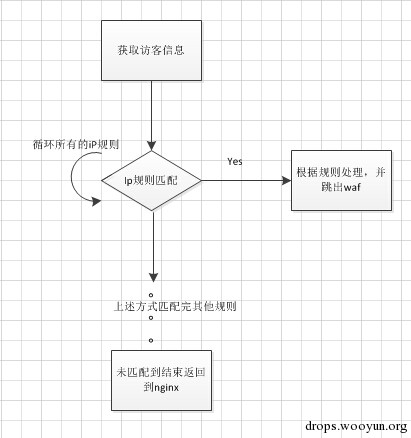
WAF主要分为硬件WAF和软件防火墙,硬件WAF如绿盟的NSFOCUS Web Application Firewall,软件防火墙比较有名的是ModSecurity,再就是代码级别的ngx_lua_waf。下面谈谈个人对几款防火墙的理解:
硬件WAF个人觉得只适合在那种访问量较少的网站,比如政府网站,公司的介绍网站等等。硬件WAF的的优势在于规则有专门的安全公司维护,管理方便,但也存在一个致命的弱点,使用传统的方式来解包到应用层对性能的需求较高,而且当访问量很大的时候延时比较大,这样在高并发访问的情况下要使用硬件WAF就只能使用很多台WAF了,这样成本就非常高了;还有一个在接触过程中发现的问题,就是硬件WAF的规则虽然多而且有人维护,但是一般公司很难敢直接开启阻难,很多都是只记录,并不能阻难,这样WAF的意义就变得小多了。
ModSecurity在网上的评价都是很高的,性能高,规则全。最开始我研究的也是这款WAF,但是在实际使用过程中发现问题,就是在高并发的情况下,运行一段时间,会出现内存飙升,而且不下来的问题。这个问题再ModSecurity的讨论论坛上面也发现了有人提出这样的问题,但一直未解决(https://github.com/SpiderLabs/ModSecurity/issues/785)。针对于规则全的优势,一般使用者也不敢直接开启所有的规则拦截,毕竟每个公司的业务不同,规则也不可能直接套用。
基于高性能,低成本的想法,[email protected]_lua_waf,经过实际使用下来,确实性能极好,由于LUA语言的性能是接近于C的,而且ngx_lua_module本身就是基于为nginx开发的高性能的模块。安全宝的云 WAF,以及cloudflare的新waf也是基于此模块使用LUA开发的。结合ModSecurity的思路,[email protected]_lua_waf来开发适合自己用的WAF,[email protected],再此也表示感谢。
WAF开发过程中的主要方向为:
WAF的主要功能为:
WAF的总体检测思路:
图示如下:

规则说明:
比如规则:{"rule00001","rules","args|post|cookie",[[../]],"deny","logon"},
rule00001:规则编号,随意写
rules:规则名称,如xssrules,随意写
args|post|cookie|header:检测位置,|表示或,args,post,cookie,header可多选
../:匹配的正则表达式,标准PCRE正则
deny:处理方式,可选deny ,allow
logon:日志记录与否,可选logon,logoff
#!bash
--在nginx.conf的HTTP中加入
--lua_shared_dict limit 50m; 根据主机内存调合适的值
--lua_shared_dict iplimit 20m;
--lua_shared_dict blockiplimit 5m;
-------------------------------------------------------------
CCDeny="on" --cc攻击开关
CCrate="60/60"--基于url的计数 次/秒
ipCCrate="600/60"--基于ip的计数 次/秒
-------------------------------------------------
ccdenyrules={"ccdeny1","ccdeny","","","","logon"}
function gethost()
host = ngx.var.host
if host == nil or type(host) ~= "string" then
math.randomseed(os.time())
host = "nohost"..math.random()
end
return host
end
function denycc(clientdata)
if CCDeny=="on" then
local uri=clientdata[2]
local host = gethost()
CCcount=tonumber(string.match(CCrate,'(.*)/'))
CCseconds=tonumber(string.match(CCrate,'/(.*)'))
ipCCcount=tonumber(string.match(ipCCrate,'(.*)/'))
ipCCseconds=tonumber(string.match(ipCCrate,'/(.*)'))
local token = clientdata[1]..host..uri
local clientip = clientdata[1]..host
local limit = ngx.shared.limit
local iplimit = ngx.shared.iplimit
local blockiplimit = ngx.shared.blockiplimit
local req,_=limit:get(token)
local ipreq,_=iplimit:get(clientip)
local blockipreq,_=blockiplimit:get(clientip)
if blockipreq or ipreq then
if blockipreq or req then
if blockipreq or req >= CCcount or ipreq >= ipCCcount then
log(ccdenyrules,clientdata)
blockiplimit:set(clientip,1,300)
ngx.exit(403)
return true
else
limit:incr(token,1)
iplimit:incr(clientip,1)
end
else
limit:set(token,1,CCseconds)
end
else
iplimit:set(clientip,1,ipCCseconds)
end
end
return false
end
可以很灵活的实现复杂的控制
比如我在我的个人网站上面就使用了这样一个功能,后台页面需要特定useragent才能访问。
代码如下:
#!bash
--特定页面容许特定useragent可访问
function houtai(clientdata)
if stringmatch(clientdata[2],"wp-admin") then
if stringmatch(clientdata[4],"hahahaha") then
return
else
ngx.exit(403)
return
end
else
return
end
end
可以测试http://www.zhangsan.me/wp-admin/
只有在特定的useragent才可以访问此页面,否则报403错误。
源码下载地址为:http://pan.baidu.com/s/18QQya
环境搭建就参考:http://wiki.nginx.org/HttpLuaModule#Installation
waf使用主要就是配置config.lua
SecRuleEngine = "on" attacklog = "on" logpath = "/home/waflog/"
分别为引擎是否开启 是否记录日志 日志的存储路径 日志的存储路径需要给予nginx运行用户的读写权限
写的很简单,大牛勿喷,希望大家多提建议。
1. https://github.com/loveshell/ngx_lua_waf
2. http://wiki.nginx.org/HttpLuaModule
3. http://www.freebuf.com/tools/54221.html
……